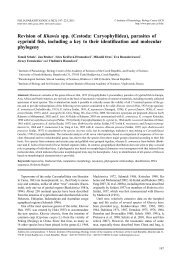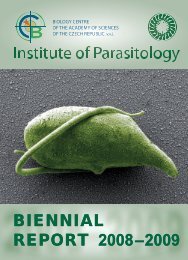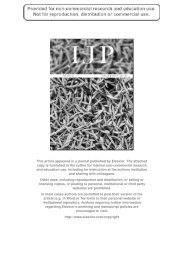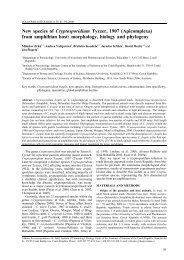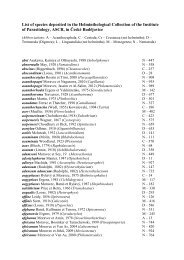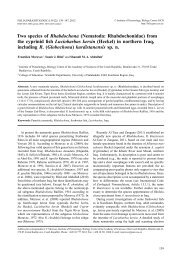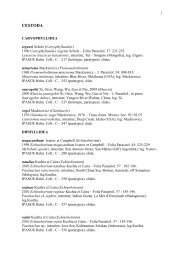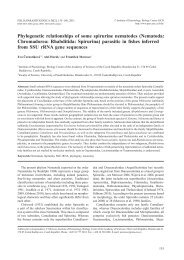Coccidia of rabbit: a review
Coccidia of rabbit: a review
Coccidia of rabbit: a review
Create successful ePaper yourself
Turn your PDF publications into a flip-book with our unique Google optimized e-Paper software.
Table 2. Findings <strong>of</strong> polynucleate merozoites in <strong>rabbit</strong> coccidia.<br />
is an integral part <strong>of</strong> their life cycle. Cheissin (1967) believes<br />
that the presence <strong>of</strong> two types <strong>of</strong> meronts in the<br />
second AG <strong>of</strong> E. magna reflects sexual dimorphism. This<br />
is also proposed by Pellérdy and Dürr (1970). Streun et<br />
al. (1979) postulated that there are two lines in the endogenous<br />
development <strong>of</strong> E. perforans: the male, represented<br />
by meronts forming polynucleate merozoites in which<br />
endomerogony (formation <strong>of</strong> daughter merozoites inside<br />
the cells as mentioned above) occurs, whereas the female<br />
line is characterised by uninucleate merozoites arising<br />
by ectomerogony (merozoites are formed in contact<br />
with plasmalemma <strong>of</strong> the meront; later they protrude into<br />
parasitophorous vacuole and mature merozoites are constricted<br />
from the mother cell). The last male (polynucleate)<br />
merozoites give rise to microgamonts and the female<br />
(uninucleate) ones to macrogamonts. Streun et al. (1979)<br />
named meronts producing polynucleate merozoites and<br />
these merozoites themselves as type A; the second being<br />
type B. This is the terminology that will be used in this<br />
<strong>review</strong> as well.<br />
Streun et al. (1979) observed that as the endogenous<br />
development progresses, the number <strong>of</strong> type A meronts<br />
decreases in subsequent generations. The fact that the<br />
microgamonts are less numerous than macrogamonts is<br />
inherent with this observation. The same is applicable for<br />
E. flavescens (Pakandl et al. 2003), E. intestinalis (Licois<br />
et al. 1992), E. magna (Pakandl et al. 1996b) E. media<br />
(Pakandl et al. 1996c), and E. vejdovskyi (Pakandl and<br />
Coudert 1999). Moreover, the suppression <strong>of</strong> the fourth<br />
AG, in which type B meronts give rise to larger numbers<br />
<strong>of</strong> merozoites than those <strong>of</strong> type A, in the precocious line<br />
<strong>of</strong> E. flavescens resulted in the enhanced proportions <strong>of</strong><br />
type A meronts in the fifth AG and microgamonts as compared<br />
with those <strong>of</strong> the parent strain. This result seems<br />
to corroborate the hypothesis pronounced by Streun et<br />
al. (1979). On the other hand, very low proportion <strong>of</strong> the<br />
156<br />
Species Stage(s) studied and polynucleate merozoites found Reference<br />
E. coecicola whole EC; polynucleate merozoites found only in the 3rd and 4th AG Pakandl et al. 1993, 1996a<br />
E. exigua whole EC Jelínková et al. 2008<br />
E. flavescens whole EC; polynucleate merozoites found only when the 5th AG develops Norton et al. 1979<br />
whole EC Pakandl et al. 2003, Pakandl 2005<br />
E. intestinalis whole EC Licois et al. 1992<br />
E. magna probably 3rd AG (5 days after inoculation) Sénaud and Černá 1969<br />
probably 3rd AG (4 days after inoculation) Danforth and Hammond 1972<br />
whole EC Ryley and Robinson 1976<br />
whole EC Pakandl et al. 1996b<br />
whole EC Cheissin 1960<br />
E. media whole EC Pakandl 1988<br />
whole EC Pakandl et al. 1996c<br />
E. perforans whole EC Streun et al. 1979<br />
E. piriformis whole EC Pakandl and Jelínková 2006<br />
E. stiedai whole EC Pellérdy and Dürr 1970<br />
probably the last AG (13 days after inoculation) Černá and Sénaud 1971<br />
E. vejdovskyi whole EC Pakandl 1988, Pakandl and Coudert 1999<br />
AG – asexual generation; EC – endogenous cycle<br />
meronts producing polynucleate merozoites in E. piriformis<br />
(Pakandl and Jelínková 2006) is not in agreement<br />
with the hypothesis that those meronts precede microgamonts.<br />
If the scheme <strong>of</strong> the life cycle proposed by Streun<br />
et al. (1979) is true, even the sporozoites, meronts and<br />
merozoites must be sexually determined. However, this<br />
hypothesis seems to be in contradiction with the fact that<br />
patent infection can be obtained after inoculation <strong>of</strong> chickens<br />
with single sporocyst or sporozoite (Lee et al. 1977,<br />
Shirley and Harvey 1996) or mice with single merozoite<br />
(Haberkorn 1970). For this reason, it is generally supposed<br />
that the development <strong>of</strong> the endogenous stages into<br />
macro- or microgamonts is induced by environmental<br />
factors rather than genetically determined. But the <strong>rabbit</strong><br />
may be an exception. Numerous attempts to obtain oocyst<br />
production for E. intestinalis have been carried out in SPF<br />
<strong>rabbit</strong> by inoculating single sporozoite or even single sporocyst,<br />
without success (Licois, pers. comm.). Smith et al.<br />
(2002) <strong>review</strong>ed various aspects <strong>of</strong> sexual determination<br />
in Apicomplexa. It seems that the commitment to male<br />
or female gametocytogenesis occurs at various points <strong>of</strong><br />
the asexual phase <strong>of</strong> their endogenous cycles (i.e. not during<br />
formation <strong>of</strong> sporozoites), since there is evidence that<br />
meronts <strong>of</strong> E. tenella and Toxoplasma gondii and cysts<br />
<strong>of</strong> Sarcocystis cruzi are differentiated and contain only<br />
merozoites or cystozoites <strong>of</strong> the same type as shown by<br />
use <strong>of</strong> cytochemistry.<br />
The development <strong>of</strong> polynucleate merozoites raises<br />
some questions. It is uncertain whether (i) type A merozoites<br />
leave the host cell and enter another one to give rise<br />
to new meronts or whether (ii) the new merozoites are<br />
formed within the same parasitophorous vacuole. Speer et<br />
al. (1973) observed polynucleate merozoites <strong>of</strong> E. magna<br />
in tissue cultures and showed that both alternatives are<br />
possible. Theoretically, polynucleate merozoites are able



